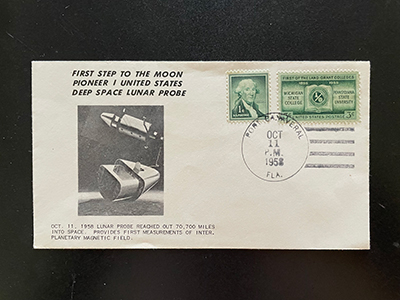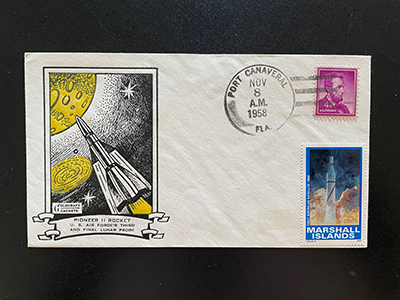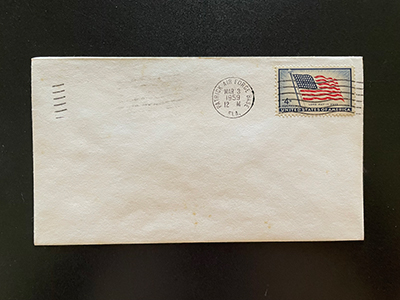|
|

|
|
Author
|
Topic: Early Pioneer lunar mission covers
|
Ken Havekotte
Member Posts: 3701
From: Merritt Island, Florida, Brevard
Registered: Mar 2001
|
 posted 08-26-2023 12:10 PM
posted 08-26-2023 12:10 PM
   
With all the recent interest in the U.S. moon-bound robotic space probes of the Ranger, Lunar Orbiter, and Surveyor cover series here, how about going back even earlier to the dawn of the Space Age when the first lunar spaceflight program by the Air Force and NASA took place.America's first launch attempt beyond Earth orbit (and to the moon) was Pioneer 0 (Able 1) on Aug. 17, 1958, mostly conducted by the Air Force Ballistic Missile Division. It was a launch failure as the three-stage Thor Able rocket exploded 10 miles high. Planned to be the first lunar probe by the U.S., the first Pioneer was to orbit far-out from the moon and take scientific measurements. I can't recall hardly seeing any space covers issued for that first U.S. lunar attempt (does anyone else)? The cover below is for Pioneer 1 (Able II) launched from the Cape's Pad 17A on Oct. 11, 1958, which was NASA's first fully operated spaceflight since the new space agency was formed that same year.  Though it got off the pad just fine, Pioneer 1 went nearly 71,000 miles into space before suffering from a second stage guidance failure and wasn't able to make lunar orbit. But during that flight time, the 84-pound spacecraft transmitted 43 hours of scientific data before reentering Earth's atmosphere two days later over the South Pacific Ocean. Besides this Sarzin cachet cover with that specific type of Port Canaveral cancel (looks good to me as it's not a clean impression), are any other cachet cover types out there that we know of?  Pioneer 2 (Able III) lifted off the Cape on Nov. 8, 1958, but failed to orbit properly because of a premature second stage cutoff. But the spacecraft did go as high as 960 miles on its way to the moon. The cover above depicts Pioneer 2's launch with a two-color designed cachet by Goldcraft Cachets and note the Port Canaveral postal strike on it (looks to be a good one)! Pioneer 3, launched to the moon on Dec. 6, 1958, failed to reach a wide lunar orbit after 63,600 miles away from Earth. I am still checking over my early cover boxes for a Pioneer 3 cover of any type. The years 1959 to 1960 saw four more Pioneer lunar mission attempts, of which, all were failures. The first successful U.S. distant fly-by of the moon was in March 1959 by Pioneer 4, also, becoming the first American space probe to leave Earth orbit successfully and enter into a solar orbit. Another cover below, but with no cachet, was for Pioneer 4's launch on March 3, 1959 with a machine cancel from Patrick AFB. It came from the collection of a Cocoa/Rockledge space cover servicer from the late 1950's until the mid-70's, M.L. Nickel, working with postal rep-canceller Dave Finney.  If there is any further interest to continue this series, I would be happy to do so, and of course would invite other lunar spaceflight cover collectors to share with some of their own early Pioneer and other U.S. lunar-related covers, such as an Explorer satellite series, Lunar Prospector, the Lunar Reconnaissance Orbiter program, and even the Artemis 1 cubesats that went to the moon last year. |
yeknom-ecaps
Member Posts: 840
From: Northville MI USA
Registered: Aug 2005
|
 posted 08-26-2023 03:12 PM
posted 08-26-2023 03:12 PM
   
Nice post Ken!See link to the discussion regarding the two types of Port Canaveral hand cancels that appear on the Sarzin (top) and Goldcraft (bottom) covers in Ken's post. |
Axman
Member Posts: 205
From: Derbyshire UK
Registered: Mar 2023
|
 posted 08-26-2023 04:01 PM
posted 08-26-2023 04:01 PM
  
I have searched for nearly two years and have not found any launch covers for Pioneer 0.I'm not saying they don't exist, someone must have posted a letter or postcard on that particular day from either Port Canaveral or PAFB, but I've not found it. I can conclusively state however that there are no 'cachet' covers for that particular launch. I do have cachet covers for the full Pioneer series after that. My first four, Pioneer 1 through 4 are all Goldcraft covers. |
Ken Havekotte
Member Posts: 3701
From: Merritt Island, Florida, Brevard
Registered: Mar 2001
|
 posted 08-26-2023 05:02 PM
posted 08-26-2023 05:02 PM
   
Always appreciate your input, Axman, and glad to hear of your complete Pioneer cover series of 1958-60, except for the first flight in August 1958. Pioneer 0, if I recall, may had been a classified or secret lunar-bound launch attempt by the Air Force Ballistic Missile Division. As the flights progressed more with new attempts, and with NASA taking over later Pioneer missions, perhaps more public information had been released earlier or right after a launch. quote:
Originally posted by yeknom-ecaps:
See link to the discussion...
Thanks Dennis for that response. We'll probably never know for certain of "NOT PROVEN" indicated earlier suspected cancelled covers referred to.
One of the stories that I made reference to concerned the possibilities of additional hand cancel devices that may had been legitimate but not necessarily used that much on public space covers. If stored and used by a station postmaster at his desk for perhaps his favorite space cover collectors and dealers that he provides cancels to, what more can be said or proven. This incident that I was told, if even true, only involved the Port/Cape Canaveral postal facility throughout some of those early space cover collecting years. If true, it could also open up backdating issues as well by that same office. |
micropooz
Member Posts: 1720
From: Washington, DC, USA
Registered: Apr 2003
|
 posted 08-26-2023 05:16 PM
posted 08-26-2023 05:16 PM
   
Great topic Ken! In fact, ya' scooped my next planned Space Cover of the Week!  But it still has some good info, so here goes: But it still has some good info, so here goes: Back on Space Cover of the Week 714 we looked at the tough time that the Ranger program had of hitting the moon. Well, even lesser known is the fact that there was a lunar program before Ranger, called Pioneer, that was even... less... successful! The cover above was postmarked at Patrick AFB on October 11, 1958, when Pioneer 1 was launched on an attempt to fly by the Moon. It actually went into a very high Earth orbit with a maximum altitude of over 71,000 miles (the Moon is at about 240,000 miles away). The Howard Farley Cachet (erroneously called a Flick Cachet before this edit) on this cover shows the conical shaped Pioneer 1 probe, weighing about 17 lbs, containing a transmitter, radiation detector, magnetometer, micrometeroid detector, temperature sensors, and a crude imager to detect if the probe passed by the Moon (Pioneer 1 obviously didn't). The cachet also states a preliminary altitude estimate of over 79,000 miles. Also the cachet mentions that this was the second attempt! And this was Pioneer 1? So here's the rest of the story... The main goals of the Pioneer Program were to test out ways to achieve escape velocity from the Earth, measure the space environment beyond Earth orbit, and try to fly-by the Moon or even enter lunar orbit. Three different launch vehicles were used in the program: 1) Thor-Able, a USAF Thor IRBM missile fitted with the two top stages of the Vanguard launch vehicle as shown on the left postcard below, 2) Juno II, an Army Jupiter IRBM missile fitted with the top three stages of the Jupiter-C launch vehicle as shown on the middle postcard below, and 3) Atlas-Able, a USAF Atlas ICBM missile fitted with the Vanguard upper stages, shown on the right postcard below.  So, here is the Pioneer lunar attempt chronology: - Pioneer "0" – August 17, 1958 on a Thor-Able launch vehicle which failed 77 seconds into the launch.
- Pioneer 1 – October 11, 1958 on a Thor-Able launch vehicle, didn't reach escape velocity but achieved high earth orbit of about 71,000 miles altitude and took environmental measurements (the cover at top).
- Pioneer 2 – November 8, 1958 on a Thor-Able launch vehicle (pictured on the above left postcard), whose third stage failed causing the probe to fall back to Earth after reaching just over 960 miles altitude.
- Pioneer 3 – December 6, 1958 on a Juno II launch vehicle, which didn't reach escape velocity but propelled the probe to an altitude of over 63,000 miles. Its tiny (2-1/2 lb) probe measured radiation.
- Pioneer 4 – March 3, 1959 on a Juno II launch vehicle finally reached escape velocity and passed within 37,000 miles of the Moon! Pioneer 4's tiny probe successfully measured radiation but was not close enough to the Moon to trigger its imaging photocell. The middle postcard above pictures this launch. Pioneer 4's launch is commemorated on the cover below postmarked at Port Canaveral on March 3, 1959, with a Goldcraft Cachet.
 - Able 4B – November 26, 1959 on an Atlas Able launch vehicle. Its much larger Pioneer probe (77 lb) was equipped to go into lunar orbit if the mission went to plan. However, the fairing over the probe disintegrated 45 seconds after launch causing the destruction of the vehicle.
- Able 5A – September 25, 1960 on an Atlas Able, intended to do the Able 4B mission. Both upper stages malfunctioned, and Able 5A didn't even achieve Earth orbit.
- Able 5B – December 15, 1960 on an Atlas Able, intended to do the Able 4B mission. Unfortunately the second stage started firing while the first stage was still attached and firing, destroying the vehicle 68 seconds after launch. This was the last lunar attempt in the Pioneer program. Further Pioneers after this did not try to reach the Moon, but targeted solar orbit and other planets.
Covers are known to exist for all the lunar attempts chronologized above, except for Pioneer 0. If you have some favorite Pioneer lunar attempt covers, please post them! And especially if you happen to have a Pioneer 0 (Aug. 17, 1958) cover! |
Ken Havekotte
Member Posts: 3701
From: Merritt Island, Florida, Brevard
Registered: Mar 2001
|
 posted 08-26-2023 06:07 PM
posted 08-26-2023 06:07 PM
   
Wow Dennis! Great job and I certainly didn't mean to take away your next topic on this forum. Thanks for continuing the later Pioneer flight series in detail as I got lazy in not offering too much information about them from Sept./Nov. 1959 to Dec. 1960 as I was trying to shorten the text of this topic.It looks like from my notes that the Pioneer P-1 launch vehicle, Atlas Able 4A (#9C) actually exploded on Pad 12 during a pre-launch static engine test on Sept. 24, 1959. Fortunately the "paddlewheel" Pioneer-W spacecraft was not fitted atop the booster and was later used on the Pioneer P-3 (X) mission in Nov. 1959. That would account why some sources don't refer to P-1 as a launched mission. Loved the picture postcards of the older launch vehicles used mostly in the early Pioneer series of that era. When I was a young wide-eyed space age kid, Dennis, space postcards for sale in our local stores here on the Florida Space Coast in 1968 were my very first affordable space souvenirs. Space covers first came to my attention in 1968.
|
yeknom-ecaps
Member Posts: 840
From: Northville MI USA
Registered: Aug 2005
|
 posted 08-26-2023 07:32 PM
posted 08-26-2023 07:32 PM
   
quote:
Originally posted by micropooz:
The Flick Cachet on this cover...
Dennis - minor correction "HF Historical Space Cover" is Howard Farley not Flick. Does your cover actually have a Flick return address on the back side of the envelope?Back in Space Cover of the Week 207 Dennis showed an extremely rare Farley first captive flight of the X-15 cover signed by Scott Crossfield. |
micropooz
Member Posts: 1720
From: Washington, DC, USA
Registered: Apr 2003
|
 posted 08-26-2023 08:19 PM
posted 08-26-2023 08:19 PM
   
Tom, you are correct! It's a Farley Cachet. My bad... | |
Contact Us | The Source for Space History & Artifacts
Copyright 2023 collectSPACE.com All rights reserved.

Ultimate Bulletin Board 5.47a
|
|

|
 advertisement advertisement

|














 But it still has some good info, so here goes:
But it still has some good info, so here goes:


